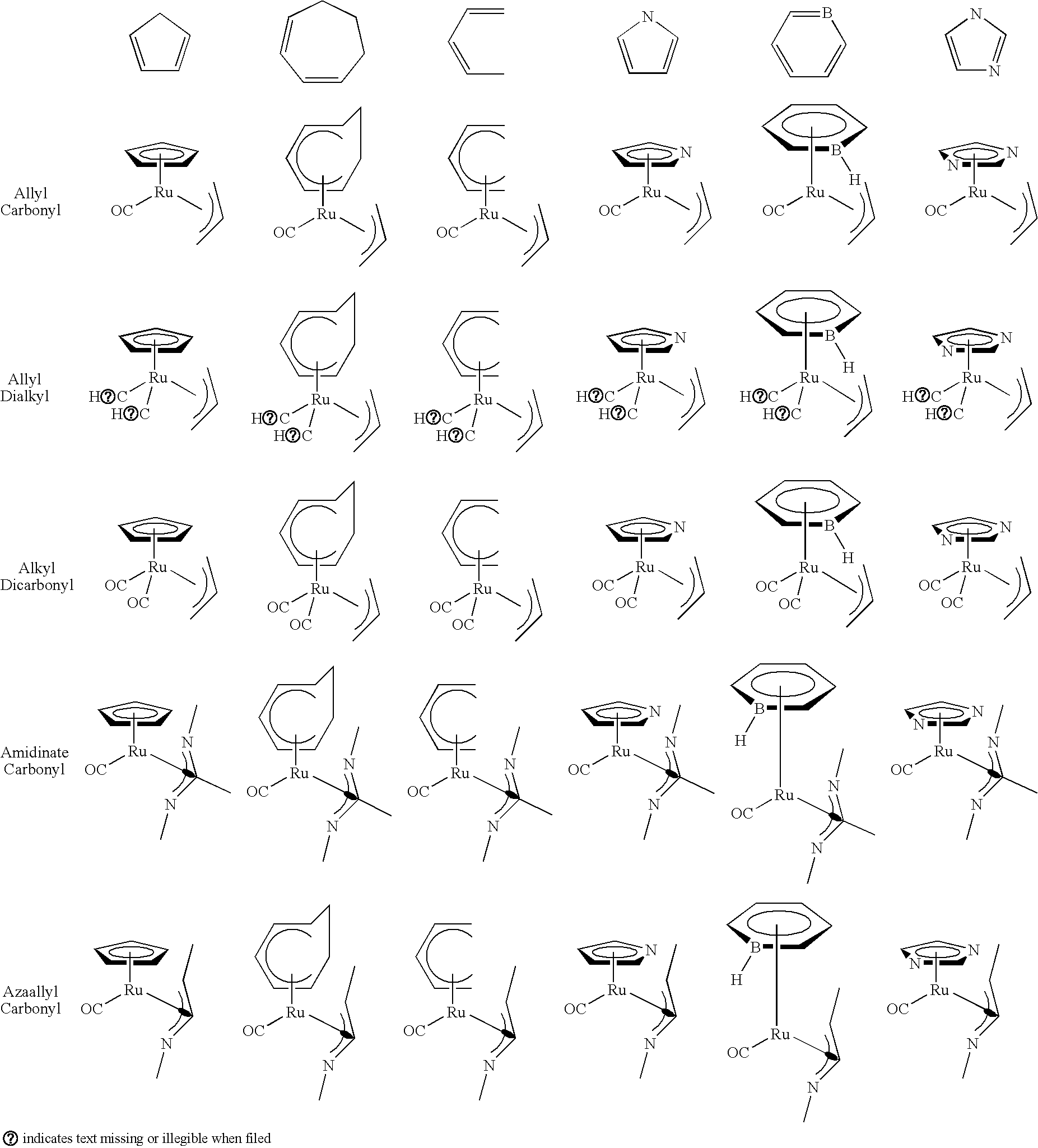Organometallic compounds, processes for the preparation thereof and methods of use thereof
a technology of organic compounds and processes, applied in the field of organic compounds, can solve the problems of low thermal stability, difficult to achieve high growth rates during film deposition, and complicate their processing, and achieve the effect of better reactivity with semiconductor substrates
- Summary
- Abstract
- Description
- Claims
- Application Information
AI Technical Summary
Benefits of technology
Problems solved by technology
Method used
Image
Examples
example 1
Synthesis of (MeCp)(1,5-hexadiene)Ru
[0202]A 100 milliliter, 3-necked round-bottomed flask equipped with a Teflon stir bar was fitted with a condenser, a glass stopper and a rubber septum. A stopcock adapter was connected to the top of the condenser and the entire system was connected to an inert atmosphere / vacuum manifold.
[0203]Under a nitrogen purge, one glass stopper was removed and the flask was charged with (MeCp)Ru(PPh3)2Cl (15.0 grams, 0.02 mol). THF (anhydrous, 30 milliliters) and ethanol (30 milliliters) were added to the 100 milliliter flask via a cannula through the rubber septum and the solution was stirred.
[0204]Zinc (10 grams, excess) was then added to the flask and the contents were permitted to stir for 30 minutes. A solution of 1,5-hexadiene in THF was prepared in a 20 milliliter flask in an inert atmosphere glovebox. The contents of this flask were then cannulated into the 100 milliliter round-bottomed flask.
[0205]The reaction was heated to reflux overnight while st...
example 2
Synthesis of CpRu(Allyl)CO
[0207]These compounds were synthesized in the manner reported in Journal of Gibson, et. al., Journal of Organometallic Chemistry, 208 (1981) 89-102.
[0208]In a 200 milliliter flask benzyltriethylammonium chloride (3.4 grams, 15 mmol) and a solution of NaOH (5N, 100 milliliters) was added. A second 500 milliliter flask was prepared by adding a CH2Cl2 (100 milliliters), allyl bromide (1.3 milliliters, 15 mmol), CpRu(CO)2Br (1.5 grams, 5 mmol) and a Teflon stir bar. The caustic aqueous solution was added rapidly and the solution was stirred during the addition. The solution was stirred for 15 minutes following the addition.
[0209]The heterogeneous solution was transferred to a separation flask and the dichloromethane product containing layer was removed. The aqueous layer was discarded. CH2Cl2 solvent removal under reduced pressure afforded a brownish-yellow residue. This residue was extracted using hexane (4 times 50 milliliters) and dried using MgSO4 then filt...
example 3
Thermogravimetric Analysis of CpRu(CO)Allyl
[0211]Thermogravimetric analyses of CpRu(CO)allyl reveal that it exhibits acceptable vapor pressure characteristics for use as a precursor. However, it also demonstrates that there are two volatile components. Based on the 1H NMR analysis these have been tentatively ascribed as the endo and exo isomers. Mixtures of both isomers or purified individual isomers (which may be afforded by purification or conversion of one isomer to the other by methods established in the literature) may likely thus be used as CVD precursor.
PUM
| Property | Measurement | Unit |
|---|---|---|
| Temperature | aaaaa | aaaaa |
Abstract
Description
Claims
Application Information
 Login to View More
Login to View More - R&D
- Intellectual Property
- Life Sciences
- Materials
- Tech Scout
- Unparalleled Data Quality
- Higher Quality Content
- 60% Fewer Hallucinations
Browse by: Latest US Patents, China's latest patents, Technical Efficacy Thesaurus, Application Domain, Technology Topic, Popular Technical Reports.
© 2025 PatSnap. All rights reserved.Legal|Privacy policy|Modern Slavery Act Transparency Statement|Sitemap|About US| Contact US: help@patsnap.com

